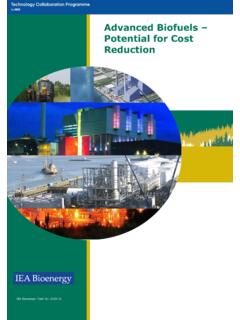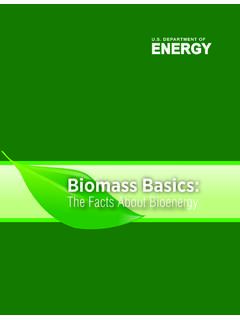Transcription of Bio-based chemicals a 2020 update final - 200213b
1 Bio-based chemicals A 2020 update This report was issued on behalf of IEA Bioenergy Task 42 biorefining in a Circular Economy. It addresses the main biobased chemicals that could potentially be co-produced with secondary energy carriers in integrated biorefinery facilities. It is an update of the 2011 report IEA Bioenergy: Task 42: 2020: 01 2 Bio-based chemicals A 2020 update February 2020 Ed de Jong, Avantium (The Netherlands) Heinz Stichnothe, Thuenen Institute of Agricultural Technology (Germany) Geoff Bell, Microbiogen (Australia) Henning J rgensen, University of Copenhagen (Denmark) With input from: Isabelle de Bari, ENEA (Italy) Jacco van Haveren, Wageningen Food & Biobased Research WFBR (The Netherlands) Johannes Lindorfer, Energieinstitut an der Johannes Kepler Universit t (Austria) Copyright 2020 IEA Bioenergy.
2 All rights Reserved ISBN 978-1-910154-69-4 (pdf version) Published by IEA Bioenergy The IEA Bioenergy Technology Collaboration Programme (IEA Bioenergy TCP) is organised under the auspices of the International Energy Agency (IEA) but is functionally and legally autonomous. Views, findings and publications of the IEA Bioenergy TCP do not necessarily represent the views or policies of the IEA Secretariat or of its individual Member countries. 3 Contents Executive summary .. 5 1. Introduction .. 7 2. Biorefineries and the Bio-based economy .. 9 3. Biorefinery platforms for chemicals production .. 12 Pyrolysis Oil Platform .. 13 Biomass Balance Approach .. 13 CO2-Platform .. 13 Syngas Platform .. 14 Sugar platform .. 15 Fermentation products from sugars.
3 16 chemical transformation products from sugars .. 17 Lignin Platform .. 17 Bio-Oil Platform .. 19 Organic Solutions Platform .. 20 4. Bio-based chemicals and Polymers - Opportunities and Growth 22 5. Economic benefit of co-production of fuel and chemicals .. 25 6. Product Commercialisation .. 28 7. Greenhouse gas GHG emission reductions and other environmental impacts through Bio-based chemical production .. 31 Oxidation state of carbon in the chemical compound .. 34 8. Future scenario s for the role of Bio-based chemicals in a sustainable and circular bioeconomy 35 9. Commercial & Near Market Products .. 39 C1 containing compounds .. 42 C2 containing compounds .. 43 C3 containing compounds .. 46 C4 containing compounds .. 51 C5 containing compounds.
4 54 C6 containing compounds .. 58 4 Higher Cn containing compounds .. 60 10. Discussion .. 63 11. Conclusions .. 65 12. Works Cited .. 66 5 Executive summary Since the first issue of the IEA Bioenergy Task 42 report on Bio-based chemicals in 2011, the importance of a circular economy has become evident. In the transition to a circular economy, chemicals and materials produced from biomass will play a key role. Given the tremendous focus on climate and actions to mitigate climate change, steps are being taken to move from today s fossil-based economy to a more sustainable economy based on renewable energy, biomass and recycling. The transition to a Bio-based circular economy has multiple drivers as well as requirements; The need to develop an environmentally, economically and socially sustainable circular global economy The desire of many countries to reduce an over dependency on fossil fuel imports by diversifying their energy sources The global issue of climate change and the need to reduce atmospheric greenhouse gases (GHG)
5 Emissions That processes and products are Safe by Design That chemicals and materials are designed for cost-, material- and energy-efficient recycling The End of Life solution of the products is equal to or preferably better than the incumbent products And deployment of biorefineries in rural areas will stimulate regional and rural development One of the key institutions to drive this transition to a more sustainable Bio-based economy is the IEA Bioenergy implementation agreement. Within IEA Bioenergy, Task 42 specifically focuses on Biorefining in a Circular Economy; the co-production of fuels, chemicals , (combined heat &) power and materials from biomass. A key factor in the deployment of a successful Bio-based economy will be the development of biorefinery systems allowing highly efficient and cost effective processing of biological feedstocks into a range of Bio-based products, and successful integration into existing infrastructure.
6 This report shows that the global Bio-based chemical and polymer production is estimated to be around 90 million tonnes. However, the relatively low price of fossil feedstocks as well as its volatility together with optimized fossil-based production processes has hampered the acceleration of the commercial production of Bio-based products as projected in the previous Bio-based chemicals report from 2011. In addition to increased recycling, enlarged chemical and polymer production from renewable resources is an essential part of the transition to a circular economy. As is evident from this report, not many major chemical players are actively pursuing this approach and that deployment over the last several years has been much slower than expected. Nevertheless, within the Bio-based economy as a whole and within the operation of a specific biorefinery there are significant opportunities for the development of Bio-based building blocks ( chemicals and polymers) and materials (fibre products, starch derivatives, etc.)
7 In many cases this happens in conjunction with the production of bioenergy or biofuels. It is estimated that the production of Bio-based products, in addition to biofuels, could generate US$ 10 billion of revenue for the global chemical industry. However, current market conditions, uncertainty about trade agreements, future carbon pricing as well as a non-holistic and polarised bioeconomy debate have hampered the deployment as well as the role-out of biobased initiatives. Within IEA Bioenergy Task 42 Biorefining in a Circular Economy , a biorefinery classification method for biorefinery systems has been developed. This classification approach relies on four main features, which are able to classify and describe a biorefinery system: 6 1) Platforms ( core intermediates such as C5 -C6 carbohydrates, syngas, lignin, pyrolytic liquid) 2) Products ( energy carriers, chemicals and material products) 3) Feedstock ( biomass, from dedicated production or residues from forestry, agriculture, aquaculture and other industry and domestic sources but also CO2) 4) Processes ( thermochemical, chemical , biochemical and mechanical processes) The platforms are the most important feature in this classification approach: they are key intermediates between raw materials and final products and can be used to link different biorefinery concepts with target markets.
8 The platforms range from single carbon molecules such as biogas and syngas to a mixed 5 and 6 carbon carbohydrates stream derived from hemicellulose, 6 carbon carbohydrates derived from starch, sucrose (sugar) or cellulose, lignin, oils (plant-based or algal), organic solutions from grasses and pyrolytic liquids. These primary platforms can be converted to a wide range of marketable products using mixtures of thermal, biological and chemical processes. In this report, a direct link is made between the different platforms and the resulting biobased chemicals . The economic production of biofuels and bioenergy is often still a challenge. The co-production of chemicals , materials, food and feed can in principle generate the necessary added value to solve the economic challenges.
9 An example is the co-production of distiller's dried grains with solubles (DDGS) and corn oil in a corn ethanol dry-milling plant. This report highlights all Bio-based chemicals with immediate potential as biorefinery value added products . For commercial products, market sizes are given where available. The selected products are either demonstrating potential market growth or have significant industry investment in development and demonstration programmes. This report shows that by far the biggest biochemical produced today is bioethanol with more than 80% share of total combined production capacity. The report introduces companies actively developing Bio-based chemicals and provides information on potential greenhouse gas emission savings and how the co-production of Bio-based chemicals with biofuel can influence the economics of biofuel production.
10 The IEA is publishing its World Energy Outlook yearly. In this outlook three different scenario s are discussed in relation to energy usage and global warming: the Current Policy scenario; the Stated Policy scenario and the Sustainable Development Scenario. Since the first publication of the Biochemical Report in 2011, the anticipated growth in biochemicals production capacity (excluding bioethanol) has not materialised yet. The main reasons for this lack of growth include the significantly lower oil prices compared to a decade ago, the different economies of scale of fossil-based plant capacities versus biobased plant capacities, high feedstock costs as well as the lack of policies, which would facilitate the transition to a biobased economy. It can therefore be concluded that the Current Policies as well as the Stated Policies for the chemical industry are not sufficient to reach the goals as defined in the Sustainable Development Scenario in a circular bioeconomy.







